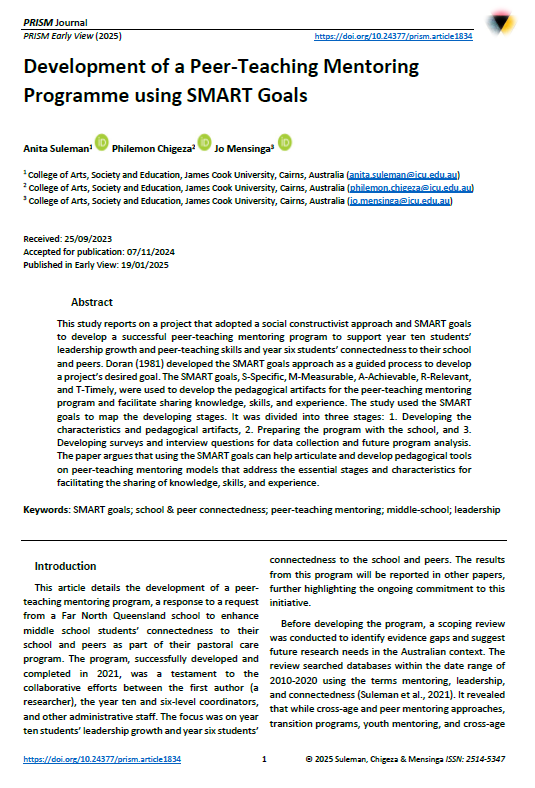Development of a Peer-Teaching Mentoring program using SMART goals
DOI:
https://doi.org/10.24377/prism.article1834Keywords:
SMART Goals, School and peer connectedness, Peer-teaching mentoring, Middle-school, LeadershipAbstract
This study reports on a project that adopted a social constructivist approach and SMART goals to develop a successful peer-teaching mentoring program to enhance year ten students' leadership growth and year six students' connectedness to their school and peers. Doran (1981, p. 16) developed the SMART goals approach as a guided process to develop a project's desired goal. The SMART goals, S-Specific, M-Measurable, A-Achievable, R-Relevant, and T-Timely, were used to develop the pedagogical artifacts for the peer-teaching mentoring program and facilitate sharing knowledge, skills, and experience. The study used the SMART goals to map the developing stages. It was divided into three stages: 1. developing the characteristics and pedagogical artifacts, 2. preparing the program with the school, and 3. developing surveys and interview questions for data collection and future program analysis. The paper argues that using the SMART goals can help articulate and develop pedagogical tools on peer-teaching mentoring models that address the essential stages and characteristics for facilitating the sharing of knowledge, skills, and experience.
Downloads

Downloads
Published
Issue
Section
License
Copyright (c) 2025 Anita Suleman, Dr Philemon Chigeza, Dr Jo Mensinga

This work is licensed under a Creative Commons Attribution-NonCommercial-NoDerivatives 4.0 International License.
Authors retain copyright and grant the journal the right of first publication with the work.
The version of the article published as part of this issue is licensed under a Creative Commons Attribution-NonCommercial-NoDerivatives 4.0 International Licence and allows others to read, download, copy, distribute, print, search, link to the full text of the first version of this article, or to use it for any other lawful purpose in accordance with the license. The author maintains copyright for the article published in this journal.
This journal provides immediate open access to its content and has no submission or publication fees.


